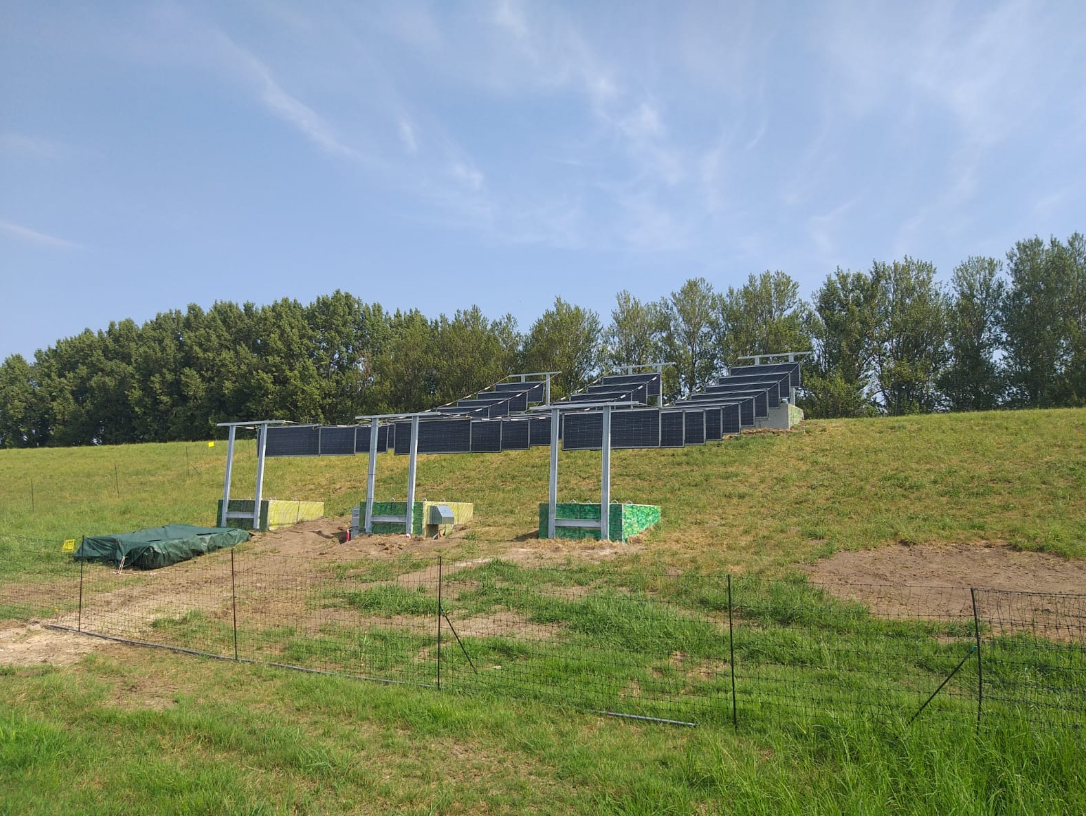
The Netherlands Organization for Applied Scientific Research (TNO) and the Zuiderzeeland Water Board (Waterschap Zuiderzeeland), in collaboration with partners, have started construction of a second pilot site as part of the Zon op Dijken ( Sun on Dikes) research project. This pilot will take place on the Knardijk in Flevoland.
The Knardijk is an inland dike that forms the boundary between East and South Flevoland in the Netherlands. Two innovative photovoltaic systems will be built and tested for water safety, among other things. The first pilot location was built at Ritthem, walso in the Netherlands. Innovation Origins reported on this earlier this year.
An overlying grass mat with sturdy roots is crucial for water safety on segments of dikes where there are no solid reinforcements. The system from Soltronergy, (a specialist in the field of solar installations) will be installed on the Knardijk. The installation takes place in such a way that the grass mat is generously provided with water and light and the grass is not adversely affected by the solar panels. This system also allows a good view of the dike, so that dike inspections can take place without any problems.
The system from Waste-care (a landfill specialist who also develops secondary construction materials) is equipped with a new type of sustainable and reinforced dike (‘Solarbase‘) on which solar panels are mounted. This concrete-like foundation can be placed on almost any surface because there is no need to drill into the ground. The intention is to extend the use of this system to future dyke reinforcement projects.
Dike inspections
After construction, which is expected to be completed in October of this year, there will be periodic inspections and continuous monitoring using a network of sensors. The TNO is responsible for measuring the energy performance of the various systems.
Wageningen University & Research monitors the effects of the solar panels on the grass mat and, together with Deltares, assesses the consequences of this for water safety. The dike will regain its original condition once the test has been completed. The consortium then comes up with a recommendation as to whether additional assessments are necessary.
Project Sun on Dikes
A consortium of government bodies, knowledge institutes, and system builders have already been researching Zon op Dijken for three years. This is led by TNO and the Dutch Foundation for Applied Water Research (STOWA, the knowledge center for all the water boards).
Research is being carried out on how solar power systems can be combined with dikes without making any concessions to the primary water-retaining function of dikes. The pilot project featuring solar panels on an inland dike in Zeeland was started earlier this year. The pilot focuses on water safety, integration into the landscape, and public support in the surrounding areas.
Read more IO articles on innovation in the Dutch province of Zeeland here.
The following is a brief excerpt of the article published by Innovation Origins earlier this year:
Zeeland aims to safeguard water safety
Gert van Kralingen, a member of the Executive Board of the Dutch Scheldestromen Water Board, says that research is needed to guarantee that solar panels do not have an adverse effect on water safety. “This is being researched, particularly in the pilot project at Ritthem, and we are pleased to be involved in this. But dikes also have a significant landscape, cultural-historical and ecological value. As far as we are concerned, these values will also be taken into account with regard to the future use of our dikes.”

